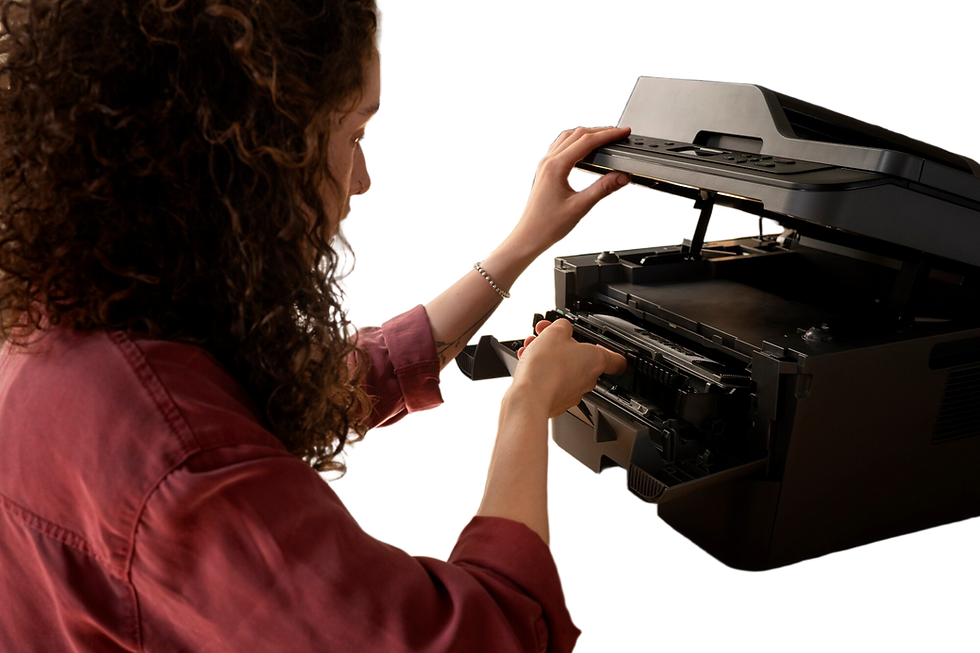How to Know if Your Printer Issues Are Software or Hardware Related
- MicroSec
- May 31
- 4 min read
Updated: Jul 18

You’re on a deadline. You hit “Print,” and… nothing happens. Your printer’s silent. Maybe it blinks. Maybe it whirs, then stops. Is it a glitch? A physical fault? A driver issue?
Before you throw the printer out the window (tempting, we know), let's break down what could really be going on—and how to figure out whether it's a software vs hardware printer issue.
Knowing the difference can save you hours of frustration, avoid unnecessary repairs, and help you decide when to call in professional support like MicroSec’s printer troubleshooting services.
Common Printer Problems: Where Do They Come From?
Printers are one of the most common (and commonly annoying) tech devices at home and in the office. The reasons they stop working can usually be grouped into two main categories:
Software-related issues: These involve your computer, drivers, network, or print settings.
Hardware-related issues: These involve physical components like the ink cartridge, paper tray, internal sensors, or printhead.
So, how do you tell which is which?
Software vs Hardware Printer Issues: How to Tell the Difference
Let’s explore how to identify whether your issue is software-related or hardware-related by following simple printer troubleshooting steps.
Step 1: Check for Error Messages
Modern printers often have small LCDs or LED light codes. These can tell you a lot.
“Driver not found,” “Cannot communicate with printer,” or “Spooling error” → These point to software issues.
“Paper jam,” “Cartridge not recognized,” or strange blinking light patterns → Usually, hardware problems.
According to a 2023 Statista report, 60% of all printer issues reported by users in North America were software-related, while 40% were hardware-related.
Step 2: Run a Printer Diagnostic Test
Most printers offer a built-in diagnostic or test print feature.
If the printer prints directly from its control panel without needing the computer, the hardware is likely fine.
If it can’t print even the test page, the issue is more likely hardware-based.
Step 3: Try a Different Device or Network
Try printing from a different computer or mobile device.
Still not printing? It's likely a hardware issue or network configuration problem.
Works fine from another device? The issue is likely software-related on your primary device.
Printer Troubleshooting Steps: Software Edition
If you're leaning toward a software issue, here are some simple fixes:
1. Check Printer Connection
Make sure the printer is connected via Wi-Fi or USB properly. Unplug and replug cables or reset your Wi-Fi.
2. Update or Reinstall Drivers
Go to your printer manufacturer’s website and download the latest drivers. A printer not working because of old or corrupted drivers is a common issue.
Use the printer’s model number (e.g., HP LaserJet Pro M404dn) to search for the exact driver.
3. Restart Print Spooler
On Windows:
Go to Services > Find “Print Spooler” > Right-click > Restart
This service manages all print jobs. Restarting it can solve queued or stuck tasks.
4. Check Default Printer Settings
Make sure your printer is set as the default in your computer’s settings. Sometimes, the wrong printer is selected (like “Print to PDF”).
Printer Troubleshooting Steps: Hardware Edition
If it seems to be a hardware problem, inspect these areas:
1. Paper Jams and Misfeeds
Open all trays and covers to check for stuck paper. Even a tiny scrap can cause problems.
2. Low or Empty Ink/Toner
Replace or refill cartridges. Some printers won’t work at all if they detect empty cartridges, even if you're trying to print in black and white.
3. Dirty or Misaligned Print Heads
If prints are streaky or missing colors, clean the print heads using the printer’s maintenance tool.
4. Broken Sensors or Rollers
If the paper isn’t feeding properly or stops halfway, internal rollers or sensors might be worn out or broken. These are classic printer hardware problems.
When to Call in Experts
Sometimes, identifying the problem is just the start. Fixing it may require deep technical know-how or access to special tools.
Signs It’s Time to Get Professional Help:
You’ve tried reinstalling drivers and restarting everything—no luck.
The printer works for some tasks but fails unpredictably.
You're seeing physical damage, internal grinding noises, or exposed wiring.
At MicroSec, we offer expert printer troubleshooting services remotely. Whether you’re dealing with a driver that just won’t install or a mysterious hardware fault, we’re here to help you get back to printing, scanning, and sharing without disruption.
What Happens If You Ignore Printer Problems?
Ignoring persistent issues can cause:
Problem | Risk |
The printer keeps failing during jobs | Productivity loss |
Driver conflict with OS updates | System crashes |
Unattended hardware faults | Permanent printer damage |
Recurring paper jams | Damaged paper trays or rollers |
A small issue today can become a big expense tomorrow. Regular maintenance and expert diagnostics go a long way in extending your printer’s life.
Final Takeaway: Diagnose Smart, Fix Faster
Understanding whether your printer issue is software or hardware-related is key to fast, effective troubleshooting. Don’t waste time guessing, follow these printer troubleshooting steps and call in experts when needed.
At MicroSec, we specialize in solving complex printing problems with ease. Whether you're a home user or managing office infrastructure, we help you determine the root cause and fix it without hassle.
Let’s Get You Printing Again
Need help figuring out your printer issue?
Connect with MicroSec’s printer troubleshooting team today for instant support and lasting solutions.



Comments